Awareness and Knowledge of Colorectal Cancer in Qassim Region, Saudi Arabia
Download
Abstract
Objective: Colorectal cancer (CRC) is a common and deadly disease. It is the third common malignancy in the world and the second leading cause of cancer-related deaths. Both environmental and genetic factors influence the risk of developing CRC. The clinical symptoms develop late in the course of the disease, and precursor lesions (adenomas) can be easily detected and removed. This study intends to evaluate the awareness of CRC in an Al-Qassim region and identify the (population) that can benefit from awareness and screening programs.
Methods and Material: Quantitative observational, cross-sectional study using a self-administered electronic questionnaire survey was employed to include all males and females (Arabic speakers and older than 18) in the Al-Qassim region (March-June 2020). The questionnaire consisted of 13 multiple choice questions and two short answer questions in the Arabic language. The data were categorized according to gender, marital status, age, level of education, and residence to determine whether these demographic groups have a difference in Knowledge about CRC.
Results: We used in the study an online distributed questionnaire, which was used before in another study. However, the assumed number needed for this study was 358; we collected 1430 responses (response rate is 400 %). In this study, the majority of the specimen was females 78 %, and 49.7 % had an age between 18 -32. the mean score of knowledge among the public in the Qassim region about CRC was 3.5573 ± 1.2664. the most symptoms related to CRC identified by the participants were blood in stool and abdominal pain, while the history of familiar CRC was the most known risk factors. The age, social status, and educational level had a significant correlation with the level of knowledge.
Conclusions: Although older married individuals with higher education had more Knowledge of CRC than others, there were some misconceptions in the surveyed population regarding the function of the colon, how common the colon cancer and when they should be screened for colon cancer.
Introduction
Colorectal cancer (CRC) is common cancer, and it ranks the third most commonly diagnosed cancer in the world [1]. CRC is also the fourth leading cause of death worldwide [2]. In Saudi Arabia, CRC is the second most common cancer, being the first among men (10.6%) and third among women (8.9%). According to the World Health Organization (WHO) in 2004, the death rate from CRC in Saudi Arabia is 8.3%. Moreover, the Saudi Cancer Registry reported an increase in CRC incidence between 2001 and 2006, and almost doubled between 1994 and
2003 [1]. In 2014, Saudi nationals present 11.5% of newly diagnosed cancer cases. Hence, CRC is a serious health risk in our community. The Eastern region shows the highest rates, followed by Riyadh, Makkah, Qassim, and Tabuk. According to Surveillance, Epidemiology, and End Results (SEER) Program and Cancer Statistics Review (CSR) 1975–2014 the median age at diagnosis of worldwide is 68 for males and 72 for females (for colon cancer) and 63 for both men and women (for rectal cancer), whereas in Saudi Arabia is 60 for men and 57 for women [4].
Furthermore, Saudi patients are more likely to present at a late stage in comparison with western countries [1]. Screening for CRC can improve early diagnosis [3]. Early screening can prevent CRC by early recognition of precancerous polyps. Screening procedures include direct visualization of lesions through a flexible sigmoidoscopy and colonoscopy; a faecal occult blood test also is used. A significant proportion of CRC cases and deaths could be avoidable due to the slow transition from adenoma to adenocarcinoma [5]. Unfortunately, participation in CRC screening worldwide is relatively low despite the significant role of CRC screening in reducing incidence and mortality rates [2]. Barriers of participation in screening programs can be grouped in patient-level factors, including socio-demographics, psychosocial factors, healthcare system, and provider factors [4].
Accordingly, interventions must focus on these factors [2, 3]. Knowledge of symptoms and risk factors encourages patients to participate in screening programs and present at an early stage [6]. The symptoms of CRC include a change in bowel habits, rectal bleeding, abdominal pain, and sudden weight loss. Age, family history of CRC, a low fiber diet, red and processed meat consumption, sedentary lifestyle, obesity, smoking, and excessive alcoholism are the risk factors of CRC [4]. Thus, evaluating the CRC knowledge in the Qassim population and assessing the awareness of CRC incidence, risk factors, symptoms, screening, and treatment according to various demographics was the aim of this research. This data will help determine specific areas in need of targeted education programs, with the overall goal of increasing participation
Materials and Methods
A quantitative observational, cross-sectional study Was employed using a self-administered electronic questionnaire in the Arabic language (Figure 1) with minor modifications to Zubaidi et al. (Figure 2) [1] questions.
Figure 1. English Version of the Questineer.
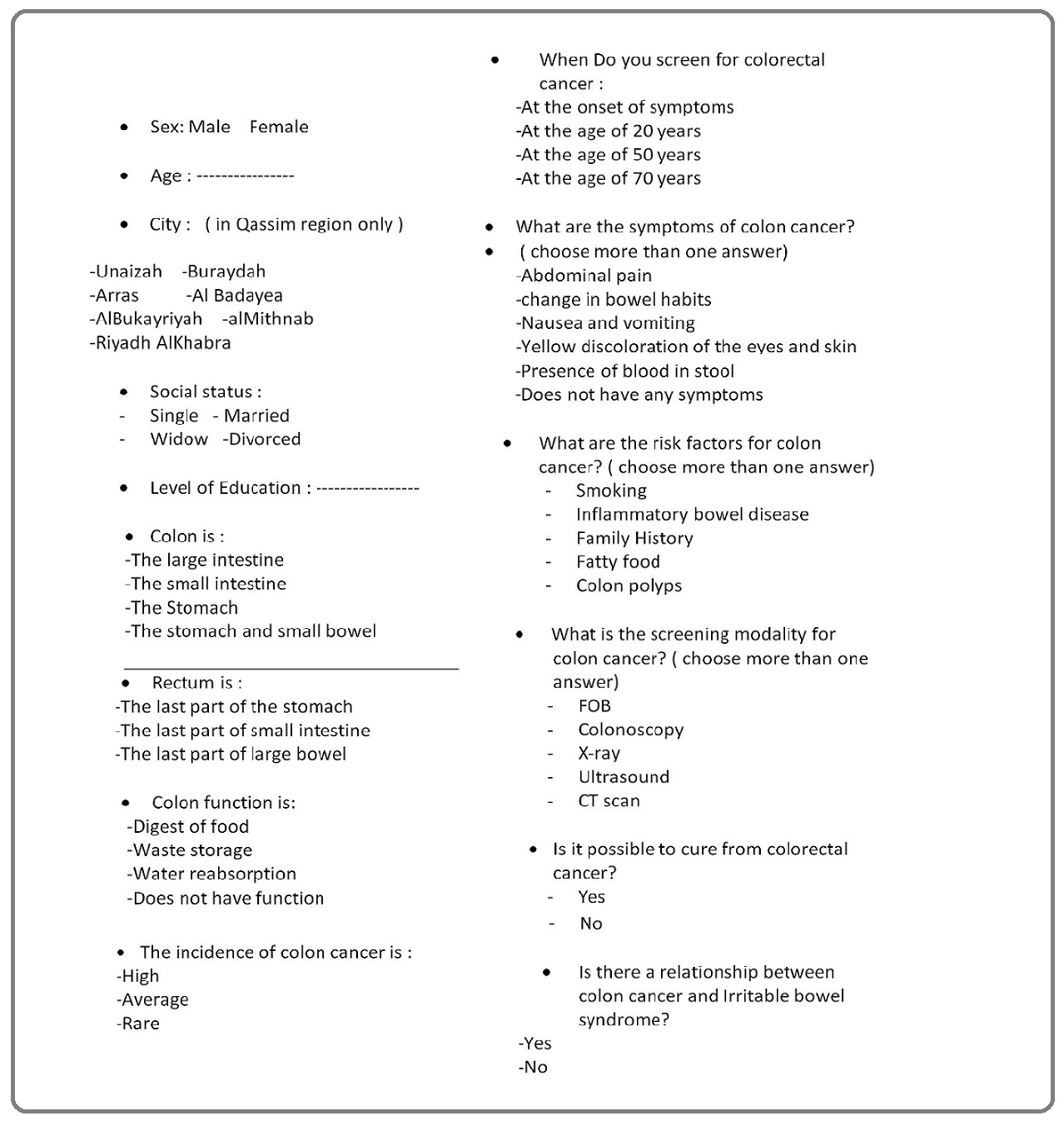
Figure 2. Questionnaire Zubaidi et al [1].
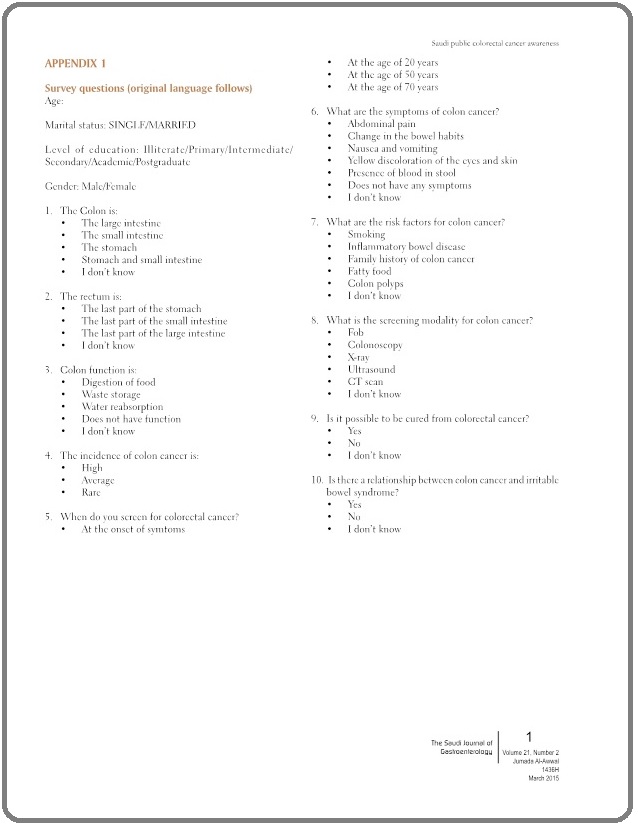
The participants selected by the convenience with the inclusion criteria of all males and females in Al-Qassim between March-June 2020 and Arabic speaker, 18 years and older.
We excluded medical students, unfinished surveys, and lack of essential ability to read or write. The questionnaire consisted of 13 multiple choice questions and two short answer questions. The components of the inquiry were socio-demographic information, questions on knowledge related to the large bowel. Awareness about early signs/symptoms and risk factors of Colorectal cancer was briefed, and the participants were instructed to select multiple answers wherever appropriate. Ethical approval was obtained from the Ethics and Research Committee of Qassim University. Data will be entered and analysed using Statistical Package for the Social Sciences (SPSS) software version 26. (IBM; Armonk, New York).
Results
One thousand four hundred thirty participants were enrolled in the study. Out of the total of 1116 (78%) were females, and 314 (22%) were males. The majority were between 18 -32 (49.7%) old. While 31.7 % were from 33-47, and 17.8% were from 48-62 years old.
Furthermore, the majority (39.4 %) of participants was from Unayzah city, Qassim SA. While (25%) were from Buraydah city, Qassim SA. (10.3) % were from Ar Rass city, 8% from Al Bukayriyah, (7.7%) from Al Mithnab city, (5.1%) from Al Badayea and (4.2%) Riyadh Al Khabra city.
The socio-demographic and characteristics of the participants, as shown in Table 1.
| Items | Frequency | Percent | |
| Gender | Male | 314 | 22 |
| Female | 1116 | 78 | |
| Age | 18-32 | 711 | 49.7 |
| 33-47 | 454 | 31.7 | |
| 48-62 | 255 | 17.8 | |
| Residence | Al Badayea | 73 | 5.1 |
| Al Bukayriyah | 114 | 8 | |
| Ar Rass | 148 | 10.3 | |
| Al Mithnab | 110 | 7.7 | |
| Buraydah | 361 | 25.2 | |
| Riyadh Al Khabra | 60 | 4.2 | |
| Unayzah | 564 | 39.4 | |
| Social status | Widower | 16 | 1.1 |
| Single | 551 | 38.5 | |
| Married | 829 | 58 | |
| Divorced | 34 | 2.4 | |
| Educational level | Primary | 9 | 0.6 |
| Inter mediate | 18 | 1.3 | |
| Secondary | 199 | 13.9 | |
| Diploma | 72 | 5 | |
| University | 1078 | 75.4 | |
| Post -graduate | 54 | 3.8 |
The majority of the participants, 829 (58.0%), were married, 18-32 years old (49.7%) university students (75.4%), and were female (78.0%).We further investigated and reported the highest percentage (33.1%) when CRC screening should occur at the age of 50. About 27.6% of participants reported that the most common symptoms of CRC are the presence of blood in the stool. Furthermore, we investigated and found most respondents (16.1%) did not know that smoking is a risk factor for CRC.
In addition, Table 1 reveals significant differences in demographic responses (level of education, age, marital status, and gender).
Level of education
Considering knowledge of participants about colorectal cancer, we performed analysis for seven questions related to the definition of the colon and related symptoms, mean knowledge was calculated. We found that the mean score of knowledge was 3.5573 ± 1.2664 (Table 2).
| Mean Knowledge | |||||
| N | Mean | "std.Deviation" | "P-value" | ||
| General score | 1430 | 3.5573 | 1.26447 | ||
| Gender | male | 314 | 3.6 | 1.3 | 0.801 |
| female | 1116 | 3.6 | 1.2 | ||
| Age | 18-32 | 711 | 3.3 | 1.3 | 0.000* |
| 33-47 | 545 | 3.7 | 1.2 | ||
| 48-62 | 255 | 4 | 1.1 | ||
| 63-75 | 10 | 3.3 | 0.9 | ||
| "Social status" | Widower | 16 | 3.6 | 1 | 0.000* |
| single | 551 | 3.3 | 1.3 | ||
| Married | 829 | 3.7 | 1.2 | ||
| divorced | 34 | 4 | 1.1 | ||
| "Educational level" | pirmary | 9 | 3.6 | 1.1 | 0.038* |
| "intermediate" | 18 | 2.9 | 1.1 | ||
| secondary | 199 | 3.5 | 1.3 | ||
| diploma | 1078 | 3.6 | 1.3 | ||
| University | 72 | 3.4 | 1.2 | ||
| "Post-graduate" | 54 | 4 | 1.3 |
In Table 3, we showed the percentage of each demographic item that answers each question in correctly. There was a significant difference concerning knowing what the colon is according to the level of education. Postgraduate selected the correct answer (over 75.9%).
| The colon is? (%) | The rectum is? (%) | Colon function is? (%) | How common is colon cancer? (%) | When is early screening for colon cancer? (%) | Can colon cancer be cured upon detec- tion? (%) | Is there a relationship between colon cancer and irritable bowel? (%) | ||
| Gender | male | 66.2 | 68.5 | 28.3 | 14.3 | 33.1 | 93 | 53.8 |
| female | 63.1 | 75.2 | 23.5 | 18.8 | 25.5 | 94.7 | 54.5 | |
| p value | 0.304 | 0.017* | 0.077 | 0.067 | 0.008* | 0.245 | 0.836 | |
| Age | 18-32 | 55.8 | 63.9 | 25.7 | 14.5 | 23.2 | 93 | 55.1 |
| 33-47 | 67 | 80.2 | 25.3 | 19.2 | 28 | 94.9 | 54.4 | |
| 48-62 | 79.2 | 89.4 | 20 | 25.5 | 37.3 | 97.3 | 52.9 | |
| 63-75 | 90 | 80 | 20 | 0 | 20 | 90 | 30 | |
| p value | 0.000* | 0.000* | 0.099 | 0.000* | 0.000* | 0.017* | 0.339 | |
| Social status | Widower | 50 | 93.8 | 0 | 25 | 25 | 100 | 68.8 |
| Single | 57.5 | 60.4 | 27.2 | 13.6 | 22.1 | 92.7 | 54.6 | |
| Married | 67.4 | 81.5 | 23.3 | 20.4 | 30.3 | 95.2 | 54 | |
| Divorced | 82.4 | 88.2 | 25 | 20.6 | 35.3 | 97.1 | 50 | |
| p value | 0.000* | 0.000* | 0.422 | 0.006* | 0.001* | 0.103 | 0.461 | |
| Educational level | Primary | 55.6 | 77.8 | 22.2 | 22.2 | 22.2 | 100 | 55.6 |
| inter mediate | 38.9 | 77.8 | 11.1 | 22.2 | 5.6 | 83.3 | 50 | |
| Secondary | 58.8 | 67.3 | 26.1 | 17.6 | 26.6 | 97.5 | 56.3 | |
| Diploma | 64.8 | 73.8 | 25 | 17.4 | 27.3 | 93.6 | 54.6 | |
| University | 59.7 | 84.7 | 12.5 | 15.3 | 38.9 | 95.8 | 50 | |
| Post - | 75.9 | 77.8 | 29.6 | 27.8 | 38.9 | 98.1 | 48.1 | |
| graduate | ||||||||
| p value | 0.010* | 0.043* | 0.936 | 0.493 | 0.058 | 0.816 | 0.322 |
However, the intermediate education selected it least frequently (538.9%; p-value 0.010).
Majority of participants knew the definition of the rectum (84.7%), Based on the level of education, likewise, there was a significant difference (P = 0.043); 84.7% of undergraduates responded correctly, although only 67.3% of people with secondary education answered correctly. However, only 67.3% of people with secondary education reacted correctly. Concerning screening for colon cancer, the majority of respondents 38.9% of postgraduates and university students agreed to screen starts at the age of 50. On the contrary, those among secondary education did not agree. There is no significant difference in the survey responses according to education level regarding inflammatory bowel syndrome causing a higher risk for CRC (P = 0.322).
Gender
In general, when it comes to CRC, gender does not significantly affect the level of knowledge (p-value 0.801), where mean scores of males and females were (3.6 for both). However, there a significant difference (p-value 0.041) concerning risk factors; we found that females have more knowledge about the risk factors than males (Table 4).
| Smoking (%) | Family history of colon cancer (%) | Fatty food (%) | Having inflammatory bowel disease (%) | Colon polyps (%) | ||
| Gender | male | 27.6 | 14.7 | 27.2 | 19.5 | 18.1 |
| female | 72.4 | 85.3 | 72.8 | 80.5 | 81.9 | |
| p value | 0.041* | |||||
| Age | 18-32 | 51.5 | 53.8 | 55 | 49.5 | 45.3 |
| 33-47 | 30 | 30.1 | 27.3 | 31.4 | 31.9 | |
| 48-62 | 18.1 | 15.8 | 16.5 | 18.3 | 22.6 | |
| 63-75 | 0.4 | 0.3 | 1.1 | 0.8 | 0.2 | |
| p value | 0.268 | |||||
| Social status | Widower | 0.8 | 0.8 | 0.5 | 1.3 | 0.7 |
| single | 43.1 | 42.6 | 43.9 | 37.8 | 35.9 | |
| Married | 53.9 | 54.1 | 53.8 | 59 | 61 | |
| divorced | 2.2 | 2.5 | 1.8 | 1.9 | 2.4 | |
| p value | 0.018* | |||||
| Educational level | primary | 0.6 | 0.3 | 1.3 | 0.6 | 0.5 |
| inter mediate | 1.2 | 0.9 | 0.9 | 1.1 | 1 | |
| secondary | 15.1 | 14 | 15.6 | 12.9 | 11 | |
| diploma | 75 | 77.1 | 74.5 | 77.1 | 78.4 | |
| University | 5.8 | 2.9 | 4.7 | 5.1 | 4.2 | |
| Post -graduate | 2.4 | 4.8 | 3.1 | 3.2 | 4.9 | |
| p value | 0.979 |
Marital status
Substantially, the married or previously married population had more Knowledge concerning CRC than those who had not already married (singles) where the p-value was 0.001 (Table 3). For instance, formerly married participants (82.4%) correctly answered that the colon as part of the large intestine; compared to single individuals only responded correctly, 57.5% of the time (P ≤0.001). In contrast, regarding screening tools for CRC, single respondents answered correctly, 57.3% opposed to married participants (Table 5).
| X-ray (%) | Barium study (%) | Microscopic stool examination (%) | Colonoscope (%) | Ultrasonic (%) | ||
| Gender | male | 21.2 | 17.4 | 23.5 | 23.2 | 22.1 |
| female | 78.8 | 82.6 | 76.5 | 76.8 | 77.9 | |
| p value | 0.095 | |||||
| Age | 18-32 | 50 | 37.4 | 56 | 69.7 | 41.8 |
| 33-47 | 31.2 | 37.2 | 27.3 | 20.3 | 35.2 | |
| 48-62 | 18 | 24.3 | 15.7 | 10 | 22.1 | |
| 63-75 | 0.8 | 1 | 0.9 | 0 | 0.8 | |
| p value | 0.000* | |||||
| Social status | Widower | 1 | 1.3 | 1.3 | 0.8 | 0.8 |
| Single | 39 | 29.5 | 45.7 | 57.3 | 32.8 | |
| Married | 58 | 65.5 | 50.9 | 40.2 | 60.7 | |
| Divorced | 2 | 3.8 | 2.1 | 1.7 | 5.7 | |
| p value | 0.000* | |||||
| Educational level | Primary | 0.5 | 0.8 | 0.9 | 0.4 | 2.5 |
| inter mediate | 1.2 | 1 | 0.9 | 1.2 | 2.5 | |
| Secondary | 13.8 | 14.4 | 15.9 | 15.8 | 13.1 | |
| Diploma | 76.1 | 73 | 75 | 75.5 | 77 | |
| University | 4.5 | 7.3 | 4.4 | 4.6 | 3.3 | |
| Post -graduate | 3.9 | 3.3 | 2.8 | 2.5 | 1.6 | |
| p value | 0.366 |
Age group
According to age, there were many significant differences in responses. For instance, respondents 63-75 years of age correctly answered that the colon is part of the large intestine (90.0%), on the other hand, the lowest correct answered by participants aged 18-32 years (55.8%; P-value ≤0.001). Concerning how common colon cancer is, only 25.5% of 48-62 years of age responded to reabsorption of water compared with 0.0% of those 60+ of age (P = 0.001). Generally, we found a significant correlation concerning symptoms of colorectal cancer. “Yellow discoloration of the eyes and skin” was the most commonly recognized symptom by participants aged 18-32 years (63.9%), compared to the older population who thought CRC has no signs (p-value 0.003) (Table 6).
| Abdominal pain (%) | The difference in the habit of directing with constipation or diarrhea (%) | The presence of blood in the stool (%) | Vomiting and nausea (%) | Yellowing of the eyes and skin (%) | Without symptoms (%) | ||
| Gender | male | 23.2 | 18.6 | 18.3 | 18.3 | 16.4 | 32.7 |
| female | 76.8 | 81.4 | 81.7 | 81.7 | 83.6 | 67.3 | |
| p value | 0.124 | ||||||
| Age | 18-32 | 55.4 | 51.7 | 47.4 | 63.9 | 64.4 | 40.4 |
| 33-47 | 26.7 | 29.7 | 32.9 | 23 | 23.6 | 42.3 | |
| 48-62 | 17.2 | 18.2 | 19 | 12.3 | 12 | 13.5 | |
| 63-75 | 0.6 | 0.4 | 0.6 | 0.8 | 0 | 3.8 | |
| p value | 0.003* | ||||||
| Social status | Widower | 1.1 | 1.1 | 0.8 | 0.8 | 0.8 | 1.9 |
| single | 44.4 | 40.7 | 36.2 | 50.3 | 54 | 30.8 | |
| Married | 51.8 | 55.9 | 60.9 | 45.8 | 43.6 | 59.6 | |
| divorced | 2.7 | 2.3 | 2.1 | 3.1 | 1.6 | 7.7 | |
| p value | 0.061 | ||||||
| Educational level | primary | 0.7 | 0.6 | 0.8 | 0.6 | 0 | 0 |
| inter mediate | 0.8 | 1.1 | 1.1 | 1.8 | 1.2 | 1.9 | |
| Secondary | 13.1 | 12.5 | 13.7 | 14.8 | 12 | 17.3 | |
| diploma | 77.6 | 77 | 75.4 | 76.8 | 79.2 | 73.1 | |
| University | 4.8 | 5.1 | 4.6 | 3.1 | 4 | 1.9 | |
| Post -graduate | 2.8 | 3.7 | 4.5 | 2.9 | 3.6 | 5.8 | |
| p value | 0.113 |
Discussion
As already reported, and to our Knowledge, Currently, data on the perception of colorectal cancer in the Qassim population have not been identified. Therefore, in this study, we aimed to evaluate the level of knowledge and awareness among public in Qassim Region regarding colorectal cancer incidence of the disease, risk factors, symptoms, screening, and treatment options, and to correlate these findings with age, gender, marital status, and educational level. The mean score of knowledge of the sample about colorectal cancer was 3.5573 ± 1.2664. This score means that most of the participants had answered almost 50 % of the questions correctly. Consequently, the general level of knowledge was moderate among the public in the Qassim region. Generally, gender does not affect while age, social status, and educational level significantly correlate with the degree of knowledge as older age, married with high education, had more understanding than others. Overall, most participants had a reasonable understanding of what colon and rectum are, however, when it came to proper colon function, how prevalent colon cancer is, and when colon cancer should be screened, there were wide gaps in knowledge.
Ahmad M. Zubaidi in his study found that most of the participants in his study had good knowledge about the location of colon and rectum however they had lower knowledge when considering the function of colon however he found that females, older respondents, and more educated respondents had (statistically significant) more Knowledge of CRC. He found that married individuals were more knowledgeable than single individuals [1]. This is in contrast to our study in the conception that females had more knowledge; in our research, we did not observe a significant correlation. The higher understanding of the married population was approved in other studies as Mohammed Alnuwaysir [7]. Most participants had a good knowledge considering the symptoms of colon cancer, especially, the presence of blood in stool and abdominal pain (Figure 3).
Figure 3. Knowlage about Symptoms of CRC.
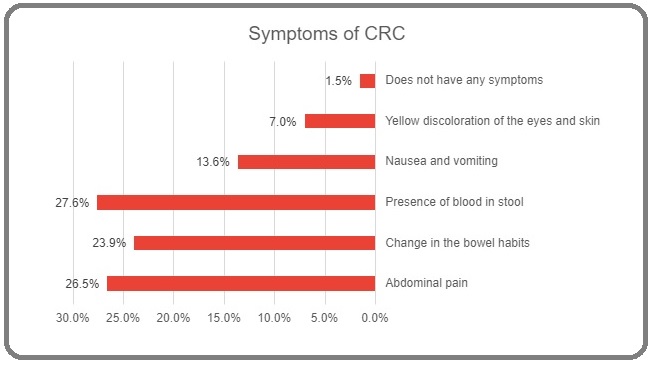
These results also found in the study of Raed Saeed Saeed, which conducted in Kuwait, where he discovered that blood stool and lower abdominal pain were the most symptoms indicated by participants [8]. Besides, Mona Abdullah Alsayed found that 21.6% of participants in her study were aware of the symptoms associated with colon cancer, where blood in the stool, weight loss, and abdominal pain were the most identified symptoms [9], and this is resembling our study. Moreover, our research results in agreement with other studies globally [10, 11]. However, many studies found that female and higher education increased the level of knowledge we did not find any association between these factors and knowledge about colon cancer symptoms. Considering risk factors, 26.7% of the sample defines inflammatory bowel disease correctly as a risk factor for CRC, while 20.9% for family history, 18.4% for polyps, 17.8% for fat-rich food, and 16.1 % for smoking Figure 4 ( risk factors).
Figure 4. Knowlage about the Risk Factors of CRC.
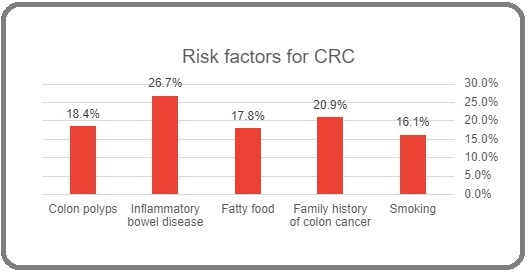
Raed Saeed Saeed found that among many risk factors provided to his participants, the main risk factors identified by them were genetic and family history [8]. Moreover, Ahmad M. Zubaidi, found that the main risk factors for developing CRC determined by the participants in his study include a family history of CRC, inflammatory bowel disease. Also, he found that older participants thought that the family history of CRC is a risk factor for CRC more than other demographics [1], and this in contrast to our results where there is no significant association between age and knowledge about risk factors.
Moreover, Nasaif et al. found in his study conducted in The Kingdom of Bahrain, which assessed the symptoms and risk factors of CRC that there were poor knowledge and awareness among Bahrainis about the signs and risk factors of CRC [12]. Considering screening tools, 45.8 % of participants thought that X-ray has a role in screening of CRC, while 20.9 % knew that microscopic stool examination and only 9.5 % choose a colonoscope as tools in screening CRC. On the other hand, 18.9% thought that barium study and 4.8% thought that ultrasound is a screening tool (Figure 5).
Figure 5. Knowledge about the Screeing Modalities of CRC.
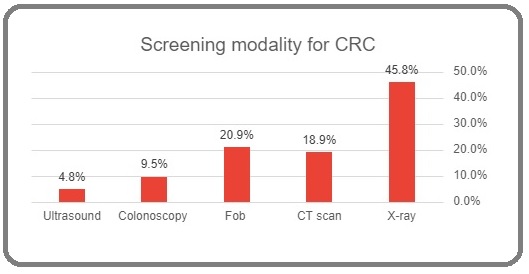
In the study of Mona Abdullah Alsayed, she found that the most critical methods of examining their participants: a colonoscopy, a CT scan of the colon, and a blood test revealed faecal [9]. Surprisingly, we did not find any correlation between gender and level of education, especially considering risk factors and symptoms. Therefore, we should aim the further educational programs to all populations and demographics Qassim region. Furthermore, many methods can be applied to increase the knowledge of the public about the CRC including providing health fairs to encourage public for early CRC screening [13], raise awareness of the public about the seriousness of CRC and how is common in Saudi Arabia than other countries especially in al Qassim region to decrease their hesitation (hesitancy) to go to clinics. Besides that, workplace screening to increase the screening rate of CRC in the different areas of Al-Qassim can be applied. Furthermore, according to our results and the results of previous studies, we found that Saudi Arabian in Qassim region lack some knowledge about CRC and thus a need for national screening program should be considered.
Still, this study is limited because of gender bias as most of the sample were female which however indicate that females are more interested in filling this type of questionnaire than male, this predominance of female makes the study not the meaning of the real population. Furthermore, most of the study was from the younger people; however, there is a proper distribution among all ages. Finally, while this study should cover the region of Qassim, it is found that most of the sample was from specific areas rather than others. Therefore, it may not be represented in the real population in Qassim region. On the other side, the study covers large sample, including all age levels, different educational and occupational levels.
In conclusion, we found that the mean score of knowledge among the public in the Qassim region about CRC was 3.5573 ± 1.2664. the most symptoms related to CRC identified by the participants were blood in stool and abdominal pain, while the history of familiar CRC was the most known risk factors. There is a lack in the Knowledge about CRC among the public in Qassim region, and there is a demand for more investigation to assess the reasons behind this profound knowledge, and to raise awareness of these symptoms, it is crucial to conduct a health promotion program to promote the public to seek medical attention.
Acknowledgements
The authors are thankful for all the participants who agreed to participate in the study
References
- Public awareness of colorectal cancer in Saudi Arabia: A survey of 1070 participants in Riyadh Zubaidi AhmadM, AlHumaid AreejA, AlKhayal KhayalA, AlObeed OmarA, AlSubaie NouraM, Shaik ShaffiA. Saudi Journal of Gastroenterology.2015;21(2). CrossRef
- Public Awareness of Colorectal Cancer Screening: Knowledge, Attitudes, and Interventions for Increasing Screening Uptake Gimeno Garcia Antonio Z., Hernandez Alvarez Buylla Noemi, Nicolas-Perez David, Quintero Enrique. ISRN Oncology.2014;2014. CrossRef
- Assessing awareness of colorectal cancer symptoms: Measure development and results from a population survey in the UK Power Emily, Simon Alice, Juszczyk Dorota, Hiom Sara, Wardle Jane. BMC Cancer.2011;11(1). CrossRef
- Assessing knowledge on preventive colorectal cancer screening in Saudi Arabia: A cross-sectional study Abdulwassi HassanK, Al-Hajeili Marwan, Alshadadi Faisal, Alqurashi Lujain, Idriss Mohmmad, Halawani Lamis. Journal of Family Medicine and Primary Care.2019;8(10). CrossRef
- A policy of screening for colorectal cancer in Saudi Arabia: A prospective analysis Aljumah AA, Aljebreen AM. Saudi journal of gastroenterology: official journal of the Saudi Gastroenterology Association.2017;23(3):161. CrossRef
- The Assessment of Awareness Level Regarding the Risk Factors and Screening of Colorectal Cancer among the People of the Northern Border Region-Kingdom of Saudi Arabia SHAH SS , WALI MB , ALHAZMI MD . .
- Colorectal Cancer Awareness and Attitude among Adult, Al-Dammam, Saudi Arabia Alnuwaysir Mohammed, Baral Nirmal, Alhadhari Hussain. Advances in Cancer Prevention.2016;01(04). CrossRef
- Knowledge and Awareness of Colorectal Cancer among General Public of Kuwait Saeed Raed Saeed, Bakir Yousif Yacoub, Alkhalifah Khalid Hussain, Ali Layla Mohammed. Asian Pacific Journal of Cancer Prevention.2018;19(9). CrossRef
- Public Awareness of Colon Cancer Symptoms, Risk Factor, and Screening at Madinah- KSA Abdullah Alsayed M, Mohammed Surrati A, Abdullah Altaifi J, Hadeed Alharbi A, Othman Alfouti R, Majed Alremaithi S. International Journal Of Pharmaceutical Research & Allied Sciences.2019;8(1):184-197.
- Assessing awareness of colorectal cancer symptoms and screening in a peripheral colorectal surgical unit: a survey based study McVeigh Terri P, Lowery Aoife J, Waldron Ronan M, Mahmood Akhtar, Barry Kevin. BMC Surgery.2013;13(1). CrossRef
- The Knowledge of Colorectal Cancer Symptoms and Risk Factors among 10,078 Screening Participants: Are High Risk Individuals More Knowledgeable? Wong Martin C. S., Hirai Hoyee W., Luk Arthur K. C., Lam Thomas Y. T., Ching Jessica Y. L., Griffiths Sian M., Chan Francis K. L., Sung Joseph J. Y.. PLoS ONE.2013;8(4). CrossRef
- Knowledge of Colorectal Cancer Symptoms and Risk Factors in the Kingdom of Bahrain: a Cross- Sectional Study Nasaif Husain A, Al Qallaf Sayed Mahmood. Asian Pacific Journal of Cancer Prevention.2018;19(8). CrossRef
- Health Fairs Greenwald Beverly. Gastroenterology Nursing.2003;26(5). CrossRef
License

This work is licensed under a Creative Commons Attribution-NonCommercial 4.0 International License.
Copyright
© Asian Pacific Journal of Cancer Care , 2021
Author Details
How to Cite
- Abstract viewed - 0 times
- PDF (FULL TEXT) downloaded - 0 times
- XML downloaded - 0 times